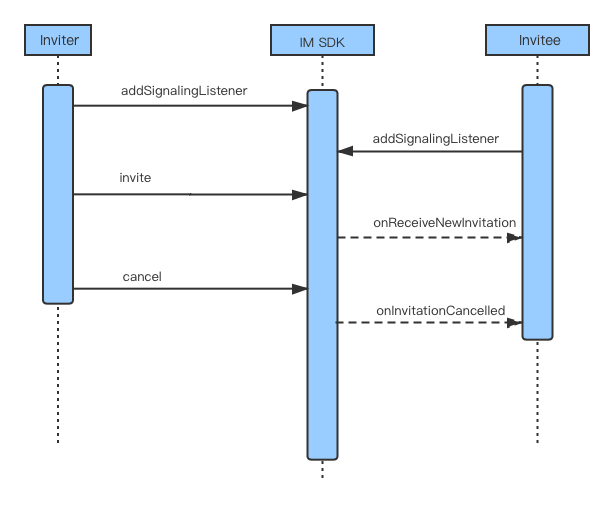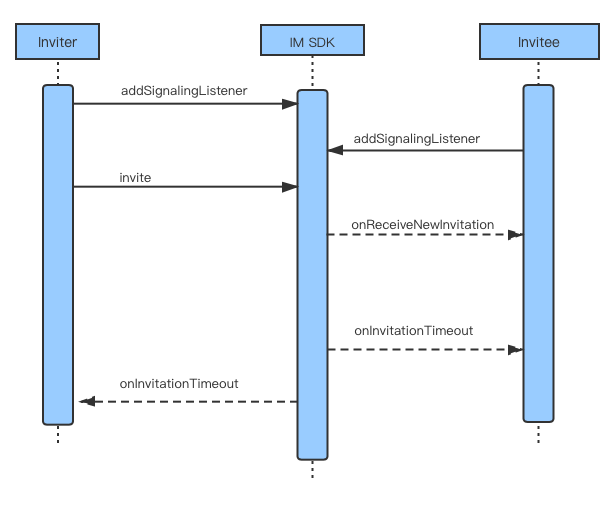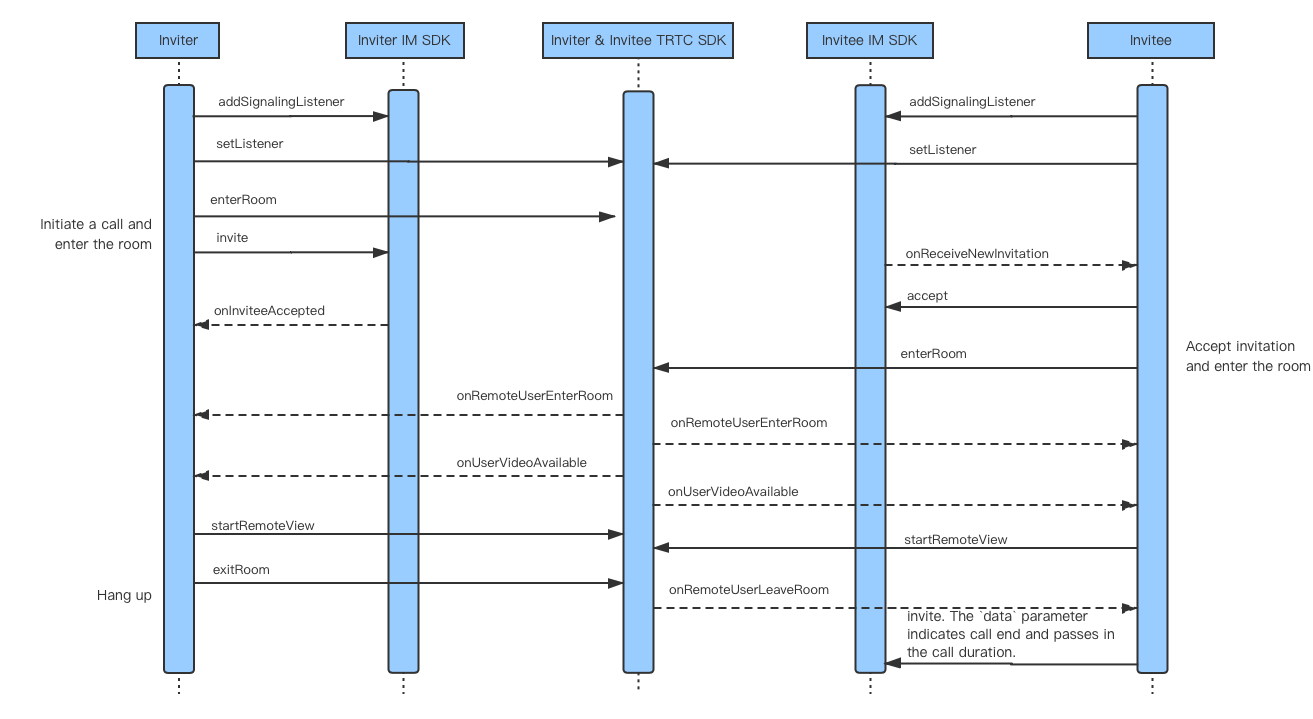- News and Announcements
- Product Introduction
- Purchase Guide
- Development Guidelines
- Demo Zone
- Download
- Chat Interaction (UI Included)
- TUIKit Library
- Getting Started
- Integrating TUIKit
- Only integrate chat
- Build Basic Interfaces
- Modifying UI Themes
- Setting UI Styles
- Implementing Local Search
- Integrating Offline Push
- User Online Status
- Typing Status
- Message Read Receipt
- Message Reactions
- Message Quotation
- Internationalization
- Adding Custom Messages
- Emoji & Stickers
- Custom UI components
- Video Call (UI Included)
- Overview (TUICallKit)
- Activate Service(TUICallKit)
- Integration(TUICallKit)
- UI Customization (TUICallKit)
- Additional Features(TUICallKit)
- API Documentation(TUICallKit)
- Release Notes (TUICallKit)
- Push Feature
- Desk
- More Practices
- No UI Integration
- SDK Integration
- Initialization
- Login and Logout
- Message
- Message Overview
- Sending Message
- Receiving Message
- Historical Message
- Forwarding Message
- Modifying Message
- Message Inserting
- Deleting Message
- Clearing Messages
- Recalling Message
- Online Message
- Read Receipt
- Querying Message
- Group @ Message
- Targeted Group Message
- Notification Muting
- Message Extension
- Message Reaction
- Message Translation
- Voice-to-Text
- Message Pinning
- Conversation
- Group
- Community Topic
- User Profile and Relationship Chain
- Offline Push
- Local Search
- Signaling
- Client APIs
- Server APIs
- Generating UserSig
- RESTful APIs
- RESTful API Overview
- RESTful API List
- Message Related
- Session Related
- Group Related
- Group Management
- Group Information
- Group Member Management
- Group Member Information
- Group Custom Attributes
- Live Group Management
- Setting Live Streaming Group Robots
- Deleting Live Streaming Group Robots
- Setting/Deleting Live Streaming Group Administrators
- Obtaining the List of Live Streaming Group Administrators
- Checking Whether Users Are in a Live Streaming Group
- Getting the Number of Online Users in an Audio-Video Group
- Getting the List of Online Members in Audio-Video Group
- Setting Audio-Video Group Member Marks
- Getting the List of Banned Group Members
- Community Management
- Creating Topic
- Deleting Topic
- Getting Topic Profile
- Modifying Topic Profile
- Importing Topic Profiles
- Permission Group Management
- Creating Permission Groups
- Terminating Permission Groups
- Modifying Permission Group Information
- Obtaining Permission Group Information
- Adding Topic Permissions
- Modifying Topic Permissions
- Deleting Topic Permissions
- Obtaining Topic Permissions
- Adding Members to a Permission Group
- Deleting Permission Group Members
- Obtaining Permission Group Member List
- Group Counter
- User Management
- Global Mute Management
- Operations Management
- Chatbots
- Official Account Management
- Webhooks
- Webhook Overview
- Webhook Command List
- Operations Management Callbacks
- Online Status Webhooks
- Relationship Chain Webhooks
- One-to-One Message Webhooks
- Group Webhooks
- Before a Group Is Created
- After a Group Is Created
- Before Applying to Join a Group
- Before Inviting a User to a Group
- After a User Joins a Group
- After a User Leaves a Group
- Before Group Message Is Sent
- After a Group Message Is Sent
- After a Group Is Full
- After a Group Is Disbanded
- After Group Profile Is Modified
- Callback After Recalling Group Messages
- Webhook for Online and Offline Status of Audio-Video Group Members
- Webhook for Exceptions When Group Messages Are Sent
- Before a Topic Is Created
- After a Topic Is Created
- After a Topic Is Deleted
- Topic Profile Change Webhook
- Callback After Group Member Profile Changed
- Callback After Group Attribute Changed
- Callback After Read Receipt
- Callback After the Group Owner Changed
- Webhooks related to the Official Account
- Before a Official Account Is Created
- After a Official Account Is Created
- After Official Account Profile Is Modified
- After Official Account Is Destroyed
- Before Official Account Is Subscribed
- After Official Account Is Subscribed
- After a Official Account Is Full
- After Official Account Is Unsubscribed
- Before Official Account Message Is Sent
- Callback After Sending an Official Account Message
- Webhook After Recalling Official Account Messages
- Console Guide
- FAQs
- Security Compliance Certification
- Chat Policies
- Migration
- Error Codes
- Contact Us
- News and Announcements
- Product Introduction
- Purchase Guide
- Development Guidelines
- Demo Zone
- Download
- Chat Interaction (UI Included)
- TUIKit Library
- Getting Started
- Integrating TUIKit
- Only integrate chat
- Build Basic Interfaces
- Modifying UI Themes
- Setting UI Styles
- Implementing Local Search
- Integrating Offline Push
- User Online Status
- Typing Status
- Message Read Receipt
- Message Reactions
- Message Quotation
- Internationalization
- Adding Custom Messages
- Emoji & Stickers
- Custom UI components
- Video Call (UI Included)
- Overview (TUICallKit)
- Activate Service(TUICallKit)
- Integration(TUICallKit)
- UI Customization (TUICallKit)
- Additional Features(TUICallKit)
- API Documentation(TUICallKit)
- Release Notes (TUICallKit)
- Push Feature
- Desk
- More Practices
- No UI Integration
- SDK Integration
- Initialization
- Login and Logout
- Message
- Message Overview
- Sending Message
- Receiving Message
- Historical Message
- Forwarding Message
- Modifying Message
- Message Inserting
- Deleting Message
- Clearing Messages
- Recalling Message
- Online Message
- Read Receipt
- Querying Message
- Group @ Message
- Targeted Group Message
- Notification Muting
- Message Extension
- Message Reaction
- Message Translation
- Voice-to-Text
- Message Pinning
- Conversation
- Group
- Community Topic
- User Profile and Relationship Chain
- Offline Push
- Local Search
- Signaling
- Client APIs
- Server APIs
- Generating UserSig
- RESTful APIs
- RESTful API Overview
- RESTful API List
- Message Related
- Session Related
- Group Related
- Group Management
- Group Information
- Group Member Management
- Group Member Information
- Group Custom Attributes
- Live Group Management
- Setting Live Streaming Group Robots
- Deleting Live Streaming Group Robots
- Setting/Deleting Live Streaming Group Administrators
- Obtaining the List of Live Streaming Group Administrators
- Checking Whether Users Are in a Live Streaming Group
- Getting the Number of Online Users in an Audio-Video Group
- Getting the List of Online Members in Audio-Video Group
- Setting Audio-Video Group Member Marks
- Getting the List of Banned Group Members
- Community Management
- Creating Topic
- Deleting Topic
- Getting Topic Profile
- Modifying Topic Profile
- Importing Topic Profiles
- Permission Group Management
- Creating Permission Groups
- Terminating Permission Groups
- Modifying Permission Group Information
- Obtaining Permission Group Information
- Adding Topic Permissions
- Modifying Topic Permissions
- Deleting Topic Permissions
- Obtaining Topic Permissions
- Adding Members to a Permission Group
- Deleting Permission Group Members
- Obtaining Permission Group Member List
- Group Counter
- User Management
- Global Mute Management
- Operations Management
- Chatbots
- Official Account Management
- Webhooks
- Webhook Overview
- Webhook Command List
- Operations Management Callbacks
- Online Status Webhooks
- Relationship Chain Webhooks
- One-to-One Message Webhooks
- Group Webhooks
- Before a Group Is Created
- After a Group Is Created
- Before Applying to Join a Group
- Before Inviting a User to a Group
- After a User Joins a Group
- After a User Leaves a Group
- Before Group Message Is Sent
- After a Group Message Is Sent
- After a Group Is Full
- After a Group Is Disbanded
- After Group Profile Is Modified
- Callback After Recalling Group Messages
- Webhook for Online and Offline Status of Audio-Video Group Members
- Webhook for Exceptions When Group Messages Are Sent
- Before a Topic Is Created
- After a Topic Is Created
- After a Topic Is Deleted
- Topic Profile Change Webhook
- Callback After Group Member Profile Changed
- Callback After Group Attribute Changed
- Callback After Read Receipt
- Callback After the Group Owner Changed
- Webhooks related to the Official Account
- Before a Official Account Is Created
- After a Official Account Is Created
- After Official Account Profile Is Modified
- After Official Account Is Destroyed
- Before Official Account Is Subscribed
- After Official Account Is Subscribed
- After a Official Account Is Full
- After Official Account Is Unsubscribed
- Before Official Account Message Is Sent
- Callback After Sending an Official Account Message
- Webhook After Recalling Official Account Messages
- Console Guide
- FAQs
- Security Compliance Certification
- Chat Policies
- Migration
- Error Codes
- Contact Us
Overview
Signaling APIs are a set of invitation process control APIs based on IM messages. They can be used to implement a variety of real-time features, including:
Audio-video chat rooms: mic on or mic off
Chatting: audio/video calls
Education: control of the process for teachers to invite students to "raise hands"
Features
Signaling APIs support the following features:
One-to-one chat invitation
You can use the invite signaling API to make an point-to-point call. When receiving the invitation notification onReceiveNewInvitation, the invitee can choose to accept the invitation, reject, or wait until the invitation times out.
Group chat invitation
Members of the group can initiate a group call invitation via inviteInGroup within the group. When receiving the invitation onReceiveNewInvitation, an invitee can choose to accept, reject, or wait until the invitation times out.
Canceling an invitation
Before an invitation times out and the invitee processes the invitation, the inviter can cancel the invitation via cancel. After the inviter cancels the invitation, an invitee will receive a cancellation notification onInvitationCancelled, and the invitation process ends.

Accepting an invitation
When receiving an invitation onReceiveNewInvitation, an invitee can accept the invitation via accept before the invitation times out and the inviter cancels the invitation. If the invitee accepts the invitation, the inviter will receive an invitation acceptance notification onInviteeAccepted. After the processing (including acceptance, rejection, and timeout) at the invitee side ends, the invitation process ends.

Rejecting an invitation
When receiving an invitation notification onReceiveNewInvitation, an invitee can reject the invitation via reject before the invitation times out and the inviter cancels the invitation. If the invitee rejects the invitation, the inviter will receive an invitation rejection notification onInviteeRejected. After the processing (including acceptance, rejection, and timeout) at the invitee side ends, the invitation process ends.
Invitation timeout
If the timeout duration of the invitation API is greater than 0 and an invitee does not respond within the timeout duration, the invitation times out, and the inviter and invitee will receive a timeout notification onInvitationTimeout. After the processing (including acceptance, rejection, and timeout) at the invitee side ends, the invitation process ends. If the timeout duration of the invitation API is 0, there will be no timeout notification.

Use Cases
Audio/Video call
In the open-source project TRTCFlutterScenesDemo, we developed an audio/video call solution suitable for one-to-one and multi-person chatting based on TRTC. You can directly modify the demo for adaptation. The following takes the one-to-one video call process as an example to introduce how signaling APIs work with the TRTC SDK.
One-to-one video call process:
1. The inviter enters the TRTC room based on the room ID generated at the service layer and calls the signaling invitation API invite to initiate an audio/video call request, including the room ID in the custom field of the invitation API.
2. The invitee receives the signaling invitation notification onReceiveNewInvitation and gets the room ID based on the custom data. The invitee's phone begins to ring.
3. The invitee processes the invitation notification:
Accepting the invitation: the invitee calls the accept signaling API and enters the TRTC room based on the room ID, and calls the
openCamera() function to enable the local camera. The inviter and invitee receive the onRemoteUserEnterRoom callback from the TRTC SDK, and the systems of the two parties record the start time of the call.Rejecting the invitation: the invitee calls the reject signaling API to end the call.
If the invitee is on the phone with someone else, the invitee calls the reject signaling API to reject the invitation and specify the rejection reason (busy local line) in the custom data.
4. After the invitee answers the call and the audio/video channel between the inviter and invitee is established, both the inviter and invitee will receive the
onUserVideoAvailable event notification from the TRTC SDK, which indicates that they have received each other's video image. At this point, they can call the startRemoteView API of the TRTC SDK to display the remote video image, and the remote audio will be played back by default.5. After the call ends (either the inviter or invitee hangs up), the party who hangs up exits the TRTC room. The other party receives the
onRemoteUserLeaveRoom callback from the TRTC SDK, and its system calculates the total duration of the call and initiates an invitation again, including the call end event and call duration in the custom data to facilitate UI display.Flowchart

Education: teacher inviting students to "raise hands"
In this scenario, the teacher asks students to "raise hands" and then chooses one of the students to speak. The process is as follows:
1. The teacher calls the inviteInGroup API to invite students to "raise hands", specifying the "hand raising" operation in the custom field
data. The students receive the onReceiveNewInvitation callback.2. Based on the
inviteeList and data fields in onReceiveNewInvitation, a student determines that he/she is one of the invitees and the operation is hand raising. Then the student calls the accept API to raise her/his hand.3. If a student raises her/his hand, others can receive the onInviteeAccepted callback. The system determines that the
data field is hand raising and displays the list of students who raise hands.4. The teacher calls the inviteInGroup API to invite one of the students who raise their hands to speak. At this time, the system specifies the "speaking" operation in the custom field
data. The students receive the onReceiveNewInvitation callback.5. Based on the
inviteeList and data fields in the onReceiveNewInvitation callback, a student determines that he/she is one of the invitees and the operation is speaking. Then the student calls the accept API to speak.6. If a student speaks, others can receive the onInviteeAccepted callback, and their systems determine that the data field is speaking and display the list of students who speak.

 Yes
Yes
 No
No
Was this page helpful?